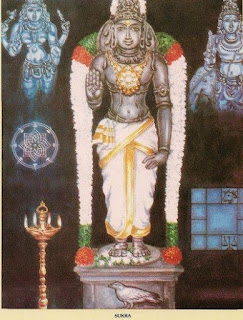Makar Sankrant (Ponggal)
Makar Sankrant celebrations focus on Vivasvan, the Sun God, whom Lord Krsna revealed in Bhagavad-Gita to be His first disciple and the embodiment of knowledge and wisdom. Vivasvan then gave Bhagavad-gita to his son, Manu, who gave it to Iksvaku.
There is a wide variation in the celebration of Makar Sankrant throughout India. Both the names and the festivities are different from region to region:
In Gujarat and Maharashtra, Makar Sankrant is celebrated with colorful kites that are flown all around.
In Punjab, Makar Sankrant is called Lohri. December and January are the coldest months of the year in Punjab, and huge bonfires are lit on the eve of Sankrant. Sweets, sugarcane and rice are thrown on the bonfires and friends and relatives gather together In Uttar Pradesh, this period is celebrated as Kicheri. It is considered auspicious to have a bath on this day and masses of people can be seen bathing in the Sangam at Prayagraj, where the rivers Ganga, Jamuna and Saraswathi flow together.
In Southern India, Makar Sankrant is the harvest fetival Pongal, which lasts for 3 days. On the first day, rice boiled with milk is offered to the Rain God. On the second day, it is offered to the Sun God and on the third day, the family cows are given a bath and dressed with flowers, bells and colors. The oxen are honored for their hard work in the fields.
In Gujarat and Maharashtra, Makar Sankrant is celebrated with colorful kites that are flown all around.
In Punjab, Makar Sankrant is called Lohri. December and January are the coldest months of the year in Punjab, and huge bonfires are lit on the eve of Sankrant. Sweets, sugarcane and rice are thrown on the bonfires and friends and relatives gather together In Uttar Pradesh, this period is celebrated as Kicheri. It is considered auspicious to have a bath on this day and masses of people can be seen bathing in the Sangam at Prayagraj, where the rivers Ganga, Jamuna and Saraswathi flow together.
In Southern India, Makar Sankrant is the harvest fetival Pongal, which lasts for 3 days. On the first day, rice boiled with milk is offered to the Rain God. On the second day, it is offered to the Sun God and on the third day, the family cows are given a bath and dressed with flowers, bells and colors. The oxen are honored for their hard work in the fields.
The day before Thai Pongal is known as Bogi Pandigai. On this day people clean their homes and light bonfire to discard unused items. In Punjab, the same day is celebrated as Lohri by the Sikh community.
Thai Pongal day is celebrated by boiling freshly harvested rice with fresh milk and jaggery in a new clay pot. While boiling the concoction, people let the milk spill over the pot as an auspicious sign of material abundance and prosperity. Later the concoction of rice, milk and jaggery, known as Pongal, is topped with brown sugar, Ghee, cashew nuts and raisins. Freshly cooked Pongal is first offered to the Sun God as gratitude for good harvesting and later served on banana leaves to the people present in the home for the ceremony. Traditionally Pongal is cooked at sunrise at an open place.
The origins of the Thai Pongal festival may date to more than 1000 years ago. Epigraphic evidence suggests the celebration of the Puthiyeedu during the Medieval Chola empire days. Puthiyeedu is believed to represent the first harvest of the year. Tamil people refer to Pongal as Tamizhar Thirunaal, the festival of Tamizhs.
Thai Pongal is the first day of Thai month according to Tamil Solar Calendar. Thai is the tenth solar month in Tamil Calendar. Thai Masam is known as Makar in other Hindu calendars.
The next day of Thai Pongal is known as Mattu Pongal. Cattles are decorated and worshipped on Mattu Pongal day.
The last and final day of Pongal is known as Kaanum Pongal. It is time for family reunions in Tamil Nadu.
Thai Pongal day is celebrated by boiling freshly harvested rice with fresh milk and jaggery in a new clay pot. While boiling the concoction, people let the milk spill over the pot as an auspicious sign of material abundance and prosperity. Later the concoction of rice, milk and jaggery, known as Pongal, is topped with brown sugar, Ghee, cashew nuts and raisins. Freshly cooked Pongal is first offered to the Sun God as gratitude for good harvesting and later served on banana leaves to the people present in the home for the ceremony. Traditionally Pongal is cooked at sunrise at an open place.
The origins of the Thai Pongal festival may date to more than 1000 years ago. Epigraphic evidence suggests the celebration of the Puthiyeedu during the Medieval Chola empire days. Puthiyeedu is believed to represent the first harvest of the year. Tamil people refer to Pongal as Tamizhar Thirunaal, the festival of Tamizhs.
Thai Pongal is the first day of Thai month according to Tamil Solar Calendar. Thai is the tenth solar month in Tamil Calendar. Thai Masam is known as Makar in other Hindu calendars.
The next day of Thai Pongal is known as Mattu Pongal. Cattles are decorated and worshipped on Mattu Pongal day.
The last and final day of Pongal is known as Kaanum Pongal. It is time for family reunions in Tamil Nadu.



Comments
Post a Comment